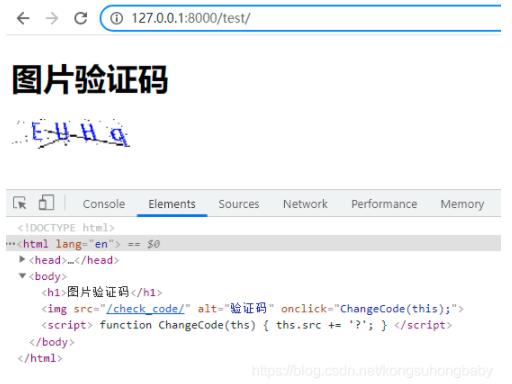python生成图片验证码
小小小小人ksh 人气:0背景
在注册或者登陆场景下,经常会遇到需要输入图片验证码的情况,最经典的就是12306买火车票。图片验证码的破解还是有一定难度的,而且如果配合上时间和次数的验证,可以很大程度上防止模拟登陆或者暴力破解,保护用户信息,同时很大程度上减少对服务器的恶意请求。今天我们就用python的django框架+PIL实现简单的图片验证码。
环境
python:3.6.5
django:3.1.6
pillow:5.2.0
【说明】:需要有django基础,比如路由、视图函数和启动命令等。
代码
check_code.py文件:
功能:
- 生成4位的随机字符串,并且将随机字符串写到图片上;
- 将随机字符串和图片格式的字符串作为返回值。
# -*- coding:utf-8 -*- import random from PIL import Image, ImageDraw, ImageFont, ImageFilter # 小写字母,去除可能会造成干扰的i,l,o,z _letter_cases = "abcdefghjkmnpqrstuvwxy" # 大写字母 _upper_cases = _letter_cases.upper() # 数字 _numbers = ''.join(map(str, range(3, 10))) init_chars = ''.join((_letter_cases, _upper_cases, _numbers)) def create_validate_code( size=(120, 30), chars=init_chars, img_type='GIF', mode='RGB', bg_color=(255, 255, 255), fg_color=(0, 0, 255), font_size=18, font_type="Monaco.ttf", length=4, draw_lines=True, n_line=(1, 2), draw_points=True, point_chance=2): """ @todo: 生成验证码图片 @param size: 图片的大小,格式(宽,高),默认为(120, 30) @param chars: 允许的字符集合,格式字符串 @param img_type: 图片保存的格式,默认为GIF,可选的为GIF,JPEG,TIFF,PNG @param mode: 图片模式,默认为RGB @param bg_color: 背景颜色,默认为白色 @param fg_color: 前景色,验证码字符颜色,默认为蓝色#0000FF @param font_size: 验证码字体大小 @param font_type: 验证码字体,默认为 ae_AlArabiya.ttf @param length: 验证码字符个数 @param draw_lines: 是否划干扰线 @param n_lines: 干扰线的条数范围,格式元组,默认为(1, 2),只有draw_lines为True时有效 @param draw_points: 是否画干扰点 @param point_chance: 干扰点出现的概率,大小范围[0, 100] @return: [0]: PIL Image实例 @return: [1]: 验证码图片中的字符串 """ # 宽和高 width, height = size # 创建图形 img = Image.new(mode, size, bg_color) # 创建画笔 draw = ImageDraw.Draw(img) def get_chars(): """生成指定长度的字符串,返回列表格式""" return random.sample(chars, length) def create_line(): """绘制干扰线条""" # 干扰线条数 line_num = random.randint(*n_line) for i in range(line_num): # 起始点 begin = (random.randint(0, size[0]), random.randint(0, size[1])) # 结束点 end = (random.randint(0, size[0]), random.randint(0, size[1])) draw.line([begin, end], fill=(0, 0, 0)) def create_points(): """绘制干扰点""" # 大小限制在[0, 100] chance = min(100, max(0, int(point_chance))) for w in range(width): for h in range(height): tmp = random.randint(0, 100) if tmp > 100 - chance: draw.point((w, h), fill=(0, 0, 0)) def create_strs(): """绘制验证码字符""" c_chars = get_chars() # 每个字符前后以空格隔开 strs = ' %s ' % ' '.join(c_chars) font = ImageFont.truetype(font_type, font_size) font_width, font_height = font.getsize(strs) draw.text(((width - font_width) / 3, (height - font_height) / 3), strs, font=font, fill=fg_color) return ''.join(c_chars) if draw_lines: create_line() if draw_points: create_points() strs = create_strs() # 图形扭曲参数 params = [1 - float(random.randint(1, 2)) / 100, 0, 0, 0, 1 - float(random.randint(1, 10)) / 100, float(random.randint(1, 2)) / 500, 0.001, float(random.randint(1, 2)) / 500 ] # 创建扭曲 img = img.transform(size, Image.PERSPECTIVE, params) # 滤镜,边界加强(阈值更大) img = img.filter(ImageFilter.EDGE_ENHANCE_MORE) return img, strs
路由:
from django.urls import path
from web.views import home, account
urlpatterns = [
path('code/', home.code),
path('test/', home.test),
]视图函数:
# encoding=utf-8
import json
import io
from django.shortcuts import render, HttpResponse, redirect
import check_code as CheckCode
def code(req):
"""
获取验证码
:param req:
:return:
"""
stream = io.BytesIO()
# 创建随机字符串code
# 创建一张图片格式的字符串,将随机字符串写到图片上
img, code = CheckCode.create_validate_code()
print('[check_code][code]:', code)
# 保存到内存中
img.save(stream, 'PNG')
req.session['CheckCode'] = code
return HttpResponse(stream.getvalue())
def test(req):
"""通过请求头获取用户设备信息"""
print(type(req))
return render(req, 'test.html')html文件:
功能:
- 给图片绑定onclick事件,这样每点击一次就重新生成一个验证码;
- img标签的src属性可以是字节流形式的图片,每次请求check_code视图函数,浏览器会将返回的图片字符串解析为图片作为src属性。
<!DOCTYPE html>
<html lang="en">
<head>
<meta charset="UTF-8">
<title>test</title>
</head>
<body>
<h1>图片验证码</h1>
<img src="/check_code/" alt="验证码" onclick="ChangeCode(this);">
<script>
function ChangeCode(ths) {
ths.src += '?';
}
</script>
</body>
</html>结果
启动django项目,浏览器访问http://127.0.0.1:8000/test/,可以看到图片验证码:

加载全部内容